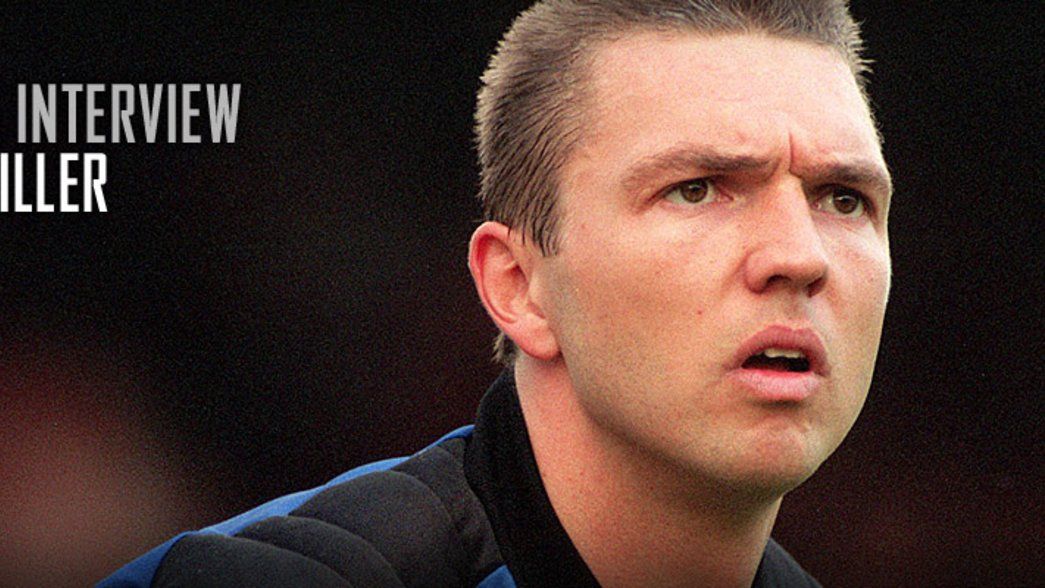Alan Miller joined Arsenal as a 16-year-old in 1986. A goalkeeper keeper of huge promise, he helped the Gunners win the FA Youth Cup in 1988, gaining promotion to the first-team squad under George Graham and going on to earn a handful of caps for England at under-21 level.
He finally made his debut on November 21, 1992 as a substitute (the first-ever Arsenal goalkeeper to come off the bench) and made another seven appearances over the next two seasons.
Though largely an unused substitute, he was part of an incredibly successful squad, picking two domestic cup winners' medals in 1993, and a Cup Winners’ Cup medal the following season.
Read the interview with Alan and more in the latest edition
However, with opportunities behind John Lukic and then David Seaman rare, he decided to move on, joining Bryan Robson and former Arsenal team-mate Viv Anderson at Middlesbrough in 1994, helping them back into the Premier League in his first season. In 1997 Miller signed for West Bromwich Albion. Further spells at Blackburn Rovers, Bristol City and Coventry City followed, as did a brief spell in Scotland with St Johnstone.
There was another League Cup final in 2002, with Blackburn, as back-up to Brad Friedel, but persistent injuries eventually got to him and he retired in 2003. After several years in the luxury tourism industry in Spain, he returned to England, and now works in the splendid setting of Holkham Hall on the north Norfolk coast.
Alan, how did you first come to join Arsenal?
I joined the club as an apprentice in 1986, which was George Graham’s first year in charge. I joined from Lilleshall School of Excellence, an institution that divided opinion in the football world. I just set about my apprenticeship, working hard and biding my time. It was an interesting time to be there. There were some big characters in the first team: Charlie Nicholas, Kenny Sansom, Viv Anderson… but the club hadn’t done much for a long time.
George Graham was quite a surprise appointment. There was a group of talented youngsters coming through like Niall Quinn, Paul Merson, David Rocastle and Michael Thomas and George decided to push them through. They were fresh and raw and keen to work. Then he signed experienced players like Dixon, Bould, Winterburn. GG knew he could manage the youngsters and the players he brought in. He was tough – a lot of it was about respect. The players played for him. And winning the Littlewoods Cup in his first year was a big boost and gave him the platform to build.
Despite not being in the squad, you were up at Anfield for that historic night in 1989. What was the story there?
Teams didn’t have goalkeepers on the bench at the time, but I was doing quite well and George Graham asked me and a couple of other young lads to travel with the team up to Liverpool for the experience. I thought that was great. It was one of the best coach trips of my life. It gave me a taste of the atmosphere and made me realise what success was all about. George Graham was good like that – he made the young players part of things. It was a fantastic period to be involved with the club, given all the young players coming through such as Kevin Campbell, Ian Selley and Ray Parlour.
Was it perhaps easier for the young outfield players to progress than for you?
Yes, as a young goalkeeper it was tough to get a break. I was still learning my trade. But training under Bob Wilson every day, and being able to learn from David Seaman, who was at the top of his game, was a fantastic experience. And the few first-team opportunities I got were incredible. In fact when I made my debut in 1992, I was the first goalkeeper in history to come on as a sub for Arsenal. That said, being realistic I knew that with David Seaman there I’d have to move on to get my chance of first-team football, so after the Cup Winners’ Cup final in 1994, I decided to leave.

Alan in action for Arsenal
You mentioned Bob Wilson. How important was he to your development as a keeper?
I had two fantastic goalkeeping coaches in my career. Bob was one, Mike Kelly, the coach with England, was the other. Bob taught me not only about the art of goalkeeping, but about how to conduct yourself, and about life. What he’s done with the Willow Foundation is incredible. I remember when I was working out in Spain we did a fundraising event for him. The people out there couldn’t believe what a nice guy he was. Arsenal recently invited me to the Norwich game. Bob went out of his way to come down and see me, which meant a lot. It was so good to see him.
You moved to Middlesbrough in 1994. How hard was it leaving the club after a decade?
My contract had ended, and I got a call from Bob Wilson to say Boro were interested. At that stage I realised I was never going to play regular first-team football if I stayed. Bryan Robson had taken over at Middlesbrough, and I went up to see him and the chairman, Steve Gibson. Viv Anderson was the assistant manager. Ayresome Park was falling to bits, but they showed me plans for the new Riverside Stadium which was going to open the following season. It was an interesting time to be there. They needed to get up to the top division that season because the promotion places were being reduced from two to one.
Bryan was still playing then – as sweeper – with Viv at right back. We managed to get promotion in my first season. I played in the last-ever game at Ayresome Park and then the first game at Riverside. When fixtures came out for the next season, the first game was at Highbury against Arsenal. When I came back, Bob Wilson came down to meet me on the steps to the main entrance. And I got a really great reception from the North Bank. People knew I hadn’t played much, but they knew I had been part of the club. And I’ll never forget how David Dein came up to the players’ lounge to say well done. That’s Arsenal for you.
After Boro you moved to West Brom – one of the clubs where you went on loan as an Arsenal youngster. How did that go?
Another great club, and in Ray Harford I had another great coach. I got on very well with Ray and had a great time there – I was picked for the PFA Team of the Season and was their Player of the Year. But there was quite a lot of turmoil at the club. Ray left and we had two different chairmen. To make matters worse, I then I had complications with a hernia. I had keyhole surgery and, looking back, I came back too quickly and ended up in hospital for a month with complications. I tried to rush back too soon to be ready for the next season – that was a mistake – it caught up with me and it probably affected me through to the end of my career.
Many players find life after Arsenal hard, given the club’s unique way of doing things. Was that the case for you?
I played for some really good clubs when I left, but when you leave Arsenal you realise that the club’s traditions and ways of doing things are special. For example the tradition of the captain deciding on the length of the shirt sleeves – day or night, hot or cold. That’s unique, and I love it. Many things may have changed now, but the core of that tradition is still there, and you still have familiar faces like David Miles and Ken Friar. And as I said before, once you’ve played for Arsenal you are always part of their history. Other clubs are big in their own way, and do things well… but wherever you go, Arsenal are respected for the way they do things. When I was elsewhere, the likes of Bryan Robson, Graham Souness, Mike Kelly all talked about THE Arsenal. The club commanded respect throughout the game.
On the subject of respect – I remember Tony Donnelly, the old kit man who was there from 1986 to 1994. When you were an apprentice you were referred to by number not by your name – “Number 12 do this.” We used to have to travel back to Highbury from Colney on Fridays to sweep and scrub the Marble Halls. And you couldn’t leave until it was spotless. I remember Tony telling me that I had to come back in on the Sunday because I hadn’t moved a box when I was sweeping.
He made me come in all the way from Essex on the Sunday morning. I asked what I had to do, but he just told me to sit there. After an hour and a half, I told him I hadn’t done anything. He said: “I know son, but I bet you move that box next time won’t you!” I’ll never forget that. It was a big learning curve. The next year he promoted me to top boy of the apprentices, and the season after that I was in the squad, and all of a sudden he was calling me by my nickname Max (coined by Pat Rice, after the comedian Max Miller), and he knew everything about me.

Alan Miller
According to your Wikipedia page, you earned a reputation as something of a practical joker at the Club. How much truth is in that?
A practical joker? Well, that’s a bit of an exaggeration I think. It was one of those things where I was at the club a long time, and being understudy to David Seaman, I wasn’t as high profile. Especially when we were on tour or on the road, it was good to have a bit of a banter, a bit of a laugh – it’s good for team bonding and I enjoyed all that. But I wouldn’t believe all the things you read on Wikipedia…
Hard to imagine that happening now. Do you think that’s a bad thing?
Football has definitely changed since those days. I am not saying it was better in my day – just that’s how it was and it taught me a lot. It’s a business now. And that’s a great thing for those who are part of it. Fantastic. Today there are great academies, great opportunities for players. Everything changes. It’s all relative.
What did you do after you retired?
When I stopped playing in 2002, I went to Spain and lived there for about seven years. I had a company called Tailor Made, looking after people who wanted ‘tailor-made’ breaks. We catered for a lot of footballers among others. Unfortunately there was then a change in the law about how rental properties were treated, which was designed to protect the local hoteliers. So I came back to England and myself and my fiancée Nerida started to run a pub and restaurant in Norfolk. We met quite a few people who worked for the nearby Holkham Hall estate. I was invited to play for the estate cricket team and one thing led to the other.
It’s a fantastic privately owned country estate of about 25,000 acres, at the heart of which is a beautiful 18th century hall, which is one of 10 ‘Treasure Houses’ in England, along with the likes of Chatsworth. Myself and Nerida now oversee the running of the estate’s cafés, with three more outlets planned. And we’ve also been involved with various outdoor concerts at Holkham Hall, for example we’ve had concerts with Jools Holland and Elton John and there are also events, such as Pedal Norfolk – a great cycling festival, which this year was attended by Emma Pooley the Olympic cycling medallist as our special guest. Working on a country estate is actually a bit like being part of a club like Arsenal – there are a lot of similarities in how things have to be managed, given that history, tradition and community all play such an important part.
Are you in touch with any of your old Arsenal team-mates?
When I went to Spain I lost contact with a lot of people from the game. Then I spoke to Andy Exley and the club invited me and a guest down to a game at the Emirates. So I took the Holkham Hall estate director, David Horton-Fawkes, to see the Norwich game last season. I went back to the Emirates to look at how they organise events, and after that I was invited to the Champions Lunch. So I’ve been back three times in short space of time. And, by weird coincidence, I actually met Alan Smith the other day in London… on the Tube! What are the chances of that?
It’s been good to be back in touch. Sitting in the directors’ box at Emirates when I was down for the Norwich game made me realise what I’d achieved by playing for this club. Once you’ve played for Arsenal – whether it’s 500 games or just a few – you are still regarded as part of the club’s history. It’s what makes it such a special place.
Do you still have any involvement in the game?
Not really. When I left for Spain, I felt I just needed a complete change. I could have gone into coaching, but it’s so insecure. As a player I’d been from London to the North East, to the Midlands, to Lancashire. I felt I needed a stable base. I’ve now found that on the north Norfolk coastline – it’s the perfect place for me and I’m doing something I really do enjoy.
You mentioned being back at Arsenal for the Champions Lunch event recently. What was that like?
It was a special occasion. The spirit we had was still in evidence. The 1989 group was a strong bunch, and that included George Graham, Theo Foley, Stuart Houston and Pat Rice – it was very apparent that the feeling within the group was still there.
For more information about Holkham Hall, visit the estate’s website here
Copyright 2025 The Arsenal Football Club Limited. Permission to use quotations from this article is granted subject to appropriate credit being given to www.arsenal.com as the source.




